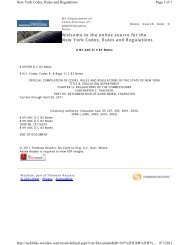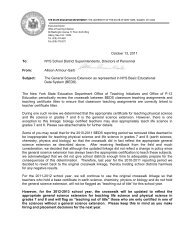ESL Learning Standards - Higher Ed - New York State Education ...
ESL Learning Standards - Higher Ed - New York State Education ...
ESL Learning Standards - Higher Ed - New York State Education ...
You also want an ePaper? Increase the reach of your titles
YUMPU automatically turns print PDFs into web optimized ePapers that Google loves.
LIMITED ENGLISH PROFICIENT ENGLISH LANGUAGE LEARNERS<br />
In <strong>New</strong> <strong>York</strong> <strong>State</strong> learners of English as a second language are students classified<br />
as “limited English proficient” because they come from a home where a language<br />
other than English is spoken and score at or below the 40 th percentile on a standardized<br />
assessment of English language proficiency. Diverse student profiles exist<br />
within the overall classification of LEP. There are LEP/ELLs who may be gifted and<br />
there are many with a high level of proficiency in their native language. Others<br />
may not be able to read or write their native language because they have had a<br />
limited or interrupted formal education in their own country. Finally, there is a<br />
population of LEP students who have been identified as having special needs and<br />
have been referred for special education services. All of these LEP students must<br />
receive instruction in <strong>ESL</strong> as shown in the following chart.<br />
Required Units of <strong>ESL</strong>/ELA Instruction<br />
LEVELS OF PROFICIENCY<br />
Grades English Beginning Intermediate Advanced Transitional<br />
K-8 <strong>ESL</strong> 2 2 1 1<br />
ELA 1 1<br />
9-12 <strong>ESL</strong> 3 2 1 1<br />
ELA 1 1<br />
Through the NYS <strong>ESL</strong> learning<br />
standards, students use<br />
English to learn English.<br />
Second language acquisition research highlights the crucial role of reading and the<br />
importance of using language in meaningful and authentic exchanges, for language<br />
growth to occur. Through authentic discourse and negotiation, at instructional levels<br />
where language is challenging and comprehensible, LEP/ELLs acquire not only<br />
effective language structures and pragmatics, but also the language needed for academic<br />
success. Students create meaning as they engage in language-rich practices<br />
both in personal interactions and through text. While language teaching continues<br />
to be made explicit in <strong>ESL</strong> classrooms, instruction based on the NYS <strong>ESL</strong> learning<br />
standards is essentially characterized by using language to learn language. In creative<br />
and meaningful language practice that typifies standards-based <strong>ESL</strong> instruction,<br />
fluency, accuracy, and application are equal partners.<br />
2 <strong>Learning</strong> <strong>Standards</strong> for <strong>ESL</strong>
















